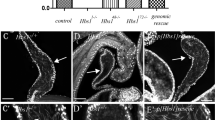Abstract
The Drosophila Pnut protein belongs to the family of septins, which are conserved GTPases participating in cytokinesis and many more other fundamental cellular processes. Because of their filamentous appearance, membrane association, and functions, septins are considered as the fourth component of the cytoskeleton, along with actin, microtubules, and intermediate filaments. However, septins are much less studied than the other cytoskeleton elements. We had previously demonstrated that the deletion of the pnut gene leads to mitotic abnormalities in somatic cells. The goal of this work was to study the role of the pnut in Drosophila spermatogenesis. We designed a construct for pnut RNA interference allowing pnut expression to be suppressed ectopically. We analyzed the effect of pnut RNA interference on Drosophila spermatogenesis. Germline cells at the earliest stages of spermatogenesis were the most sensitive to Pnut depletion: the suppression of the pnut expression at these stages leads to male sterility as a result of immotile sperm. The testes of these sterile males did not show any significant meiotic defects; the axonemes and mitochondria were normal. We also analyzed the effect of mutations in the Pnut’s conservative domains on Drosophila spermatogenesis. Mutations in the GTPase domain resulted in cyst elongation defects. Deletions of the C-terminal domain led to abnormal testis morphology. Both the GTPase domain and C-terminal domain mutant males were sterile and produced immotile sperm. To summarize, we showed that Pnut participates in spermiogenesis, that is, the late stages of spermatogenesis, when major morphological changes in spermatocytes occur.
Similar content being viewed by others
References
Akhmetova, K.A. and Fedorova, S.A., The peanut gene mutations effects on somatic and germ line cell division in Drosophila melanogaster, Russ. J. Genet.: Appl. Res., 2012, vol. 2, no. 3, pp. 229–234.
Akhmetova, K., Balasov, M., Huijbregts, R.P.H., and Chesnokov, I., Functional insight into the role of Orc6 in septin complex filament formation in Drosophila, Mol. Biol. Cell, 2015, vol. 26, no. 1, pp. 15–28. doi 10.1091/mbc.E14- 02-0734
Akhmetova, K.A., Dorogova, N.V., Chesnokov, I.N., and Fedorova, S.A., Analysis of peanut gene RNAi in drosophila oogenesis, Russ. J. Genet., 2015, vol. 51, no. 9, pp. 847–854.
Cao, L., Ding, X., Yu, W., Yang, X., Shen, S., and Yu, L., Phylogenetic and evolutionary analysis of the septin protein family in metazoan, FEBS Lett., 2007, vol. 581, pp. 5526–5532. doi 10.1016/j.febslet.2007.10.032
Casamayor, A. and Snyder, M., Molecular dissection of a yeast septin: Distinct domains are required for septin interaction, localization, and function, Mol. Cell. Biol., 2003, vol. 23, no. 8, pp. 2762–2777. doi 10.1128/MCB.23.8.2762-2777.2003
Fabian, L., Wei, H.C., Rollins, J., Noguchi, T., Blankenship, J.T., Bellamkonda, K., Polevoy, G., Gervais, L., Guichet, A., Fuller, M.T., and Brill, J.A., Phosphatidylinositol 4,5-bisphosphate directs spermatid cell polarity and exocyst localization in Drosophila, Mol. Biol. Cell, 2010, vol. 21, no. 9, pp. 1546–1555. doi 10.1091/mbc.E09-07-0582
Huijbregts, R.P., Svitin, A., Stinnett, M.W., Renfrow, M.B., and Chesnokov, I., Drosophila Orc6 facilitates GTPase activity and filament formation of the septin complex, Mol. Biol. Cell, 2009, vol. 20, pp. 270–281. doi 10.1091/mbc.E08-07-0754
Kissel, H., Georgescu, M.M., Larisch, S., Manova, K., Hunnicutt, G.R., and Steller, H., The Sept4 septin locus is required for sperm terminal differentiation in mice, Dev. Cell, 2005, vol. 8, pp. 353–364. doi 10.1016/j.devcel. 2005.01.021
Lhuillier, P., Rode, B., Escalier, D., Lorès, P., Dirami, T., Bienvenu, T., Gacon, G., Dulioust, E., and Touré, A., Absence of annulus in human asthenozoospermia: Case report, Hum. Reprod., 2009, vol. 24, no. 6, pp. 1296–1303. doi 10.1093/humrep/dep020
McMurray, M.A., Bertin, A., Garcia, G., Lam, L., Nogales, E., and Thorner, J., Septin filament formation is essential in budding yeast, Dev. Cell, 2011, vol. 20, no. 4, pp. 540–549. doi 10.1016/j.devcel.2011.02.004
Mostowy, S. and Cossart, P., Septins: The fourth component of the cytoskeleton, Nat. Rev. Mol. Cell Biol., 2012, vol. 13, no. 3, pp. 183–194. doi doi 10.1038/nrm3284
Neufeld, T.P. and Rubin, G.M., The Drosophila peanut gene is required for cytokinesis and encodes a protein similar to yeast putative bud neck filament proteins, Cell, 1994, vol. 77, pp. 371–379. doi 10.1016/0092-8674(94)90152-X
Pertceva, J.A., Dorogova, N.V., Bolobolova, E.U., Nerusheva, O.O., Fedorova, S.A., and Omelyanchuk, L.V., The role of Drosophila hyperplastic discs gene in spermatogenesis, Cell Biol. Int., 2010, vol. 10, pp. 991–996. doi 10.1042/CBI20100105
Saarikangas, J. and Barral, Y., The emerging functions of septins in metazoans, EMBO Rep., 2011, vol. 12, no. 11, pp. 1118–1126. doi 10.1038/embor.2011.193
Sirajuddin, M., Farkasovsky, M., Hauer, F., Kühlmann, D., Macara, I.G., Weyand, M., Stark, H., and Wittinghofer, A., Structural insight into filament formation by mammalian septins, Nature, 2007, vol. 449, pp. 311–315. doi 10.1038/nature06052
Sirajuddin, M., Farkasovsky, M., Zent, E., and Wittinghofer, A., GTP-induced conformational changes in septins and implications for function, Proc. Natl. Acad. Sci. U.S.A., 2009, vol. 106, no. 39, pp. 16592–16597. doi 10.1073/pnas.0902858106
Tanaka-Takiguchi, Y., Kinoshita, M., and Takiguchi, K., Septin-mediated uniform bracing of phospholipid membranes, Curr. Biol., 2009, vol. 19, no. 2, pp. 140–145. doi 10.1016/j.cub.2008.12.030
Zent, E. and Wittinghofer, A., Human septin isoforms and the GDP-GTP cycle, Biol. Chem., 2014, vol. 395, pp. 169–180. doi 10.1515/hsz-2013-0268
Author information
Authors and Affiliations
Corresponding author
Additional information
Original Russian Text © K.A. Akhmetova, N.V. Dorogova, E.U. Bolobolova, I.N. Chesnokov, S.A. Fedorova, 2016, published in Vavilovskii Zhurnal Genetiki i Selektsii, 2016, Vol. 20, No. 1, pp. 65–71.
Rights and permissions
About this article
Cite this article
Akhmetova, K.A., Dorogova, N.V., Bolobolova, E.U. et al. The role of Pnut and its functional domains in Drosophila spermatogenesis. Russ J Genet Appl Res 7, 29–35 (2017). https://doi.org/10.1134/S2079059717010026
Received:
Accepted:
Published:
Issue Date:
DOI: https://doi.org/10.1134/S2079059717010026




